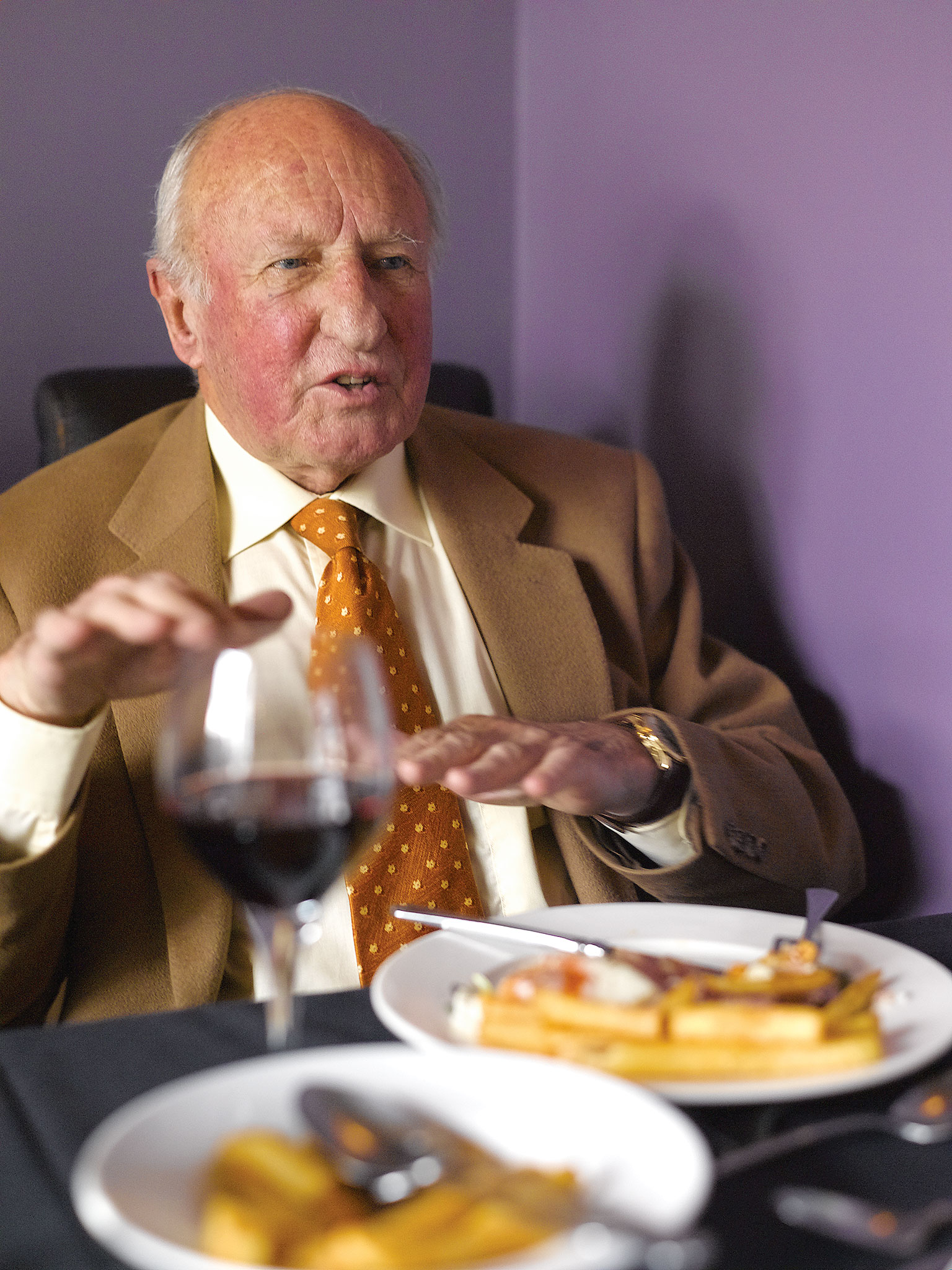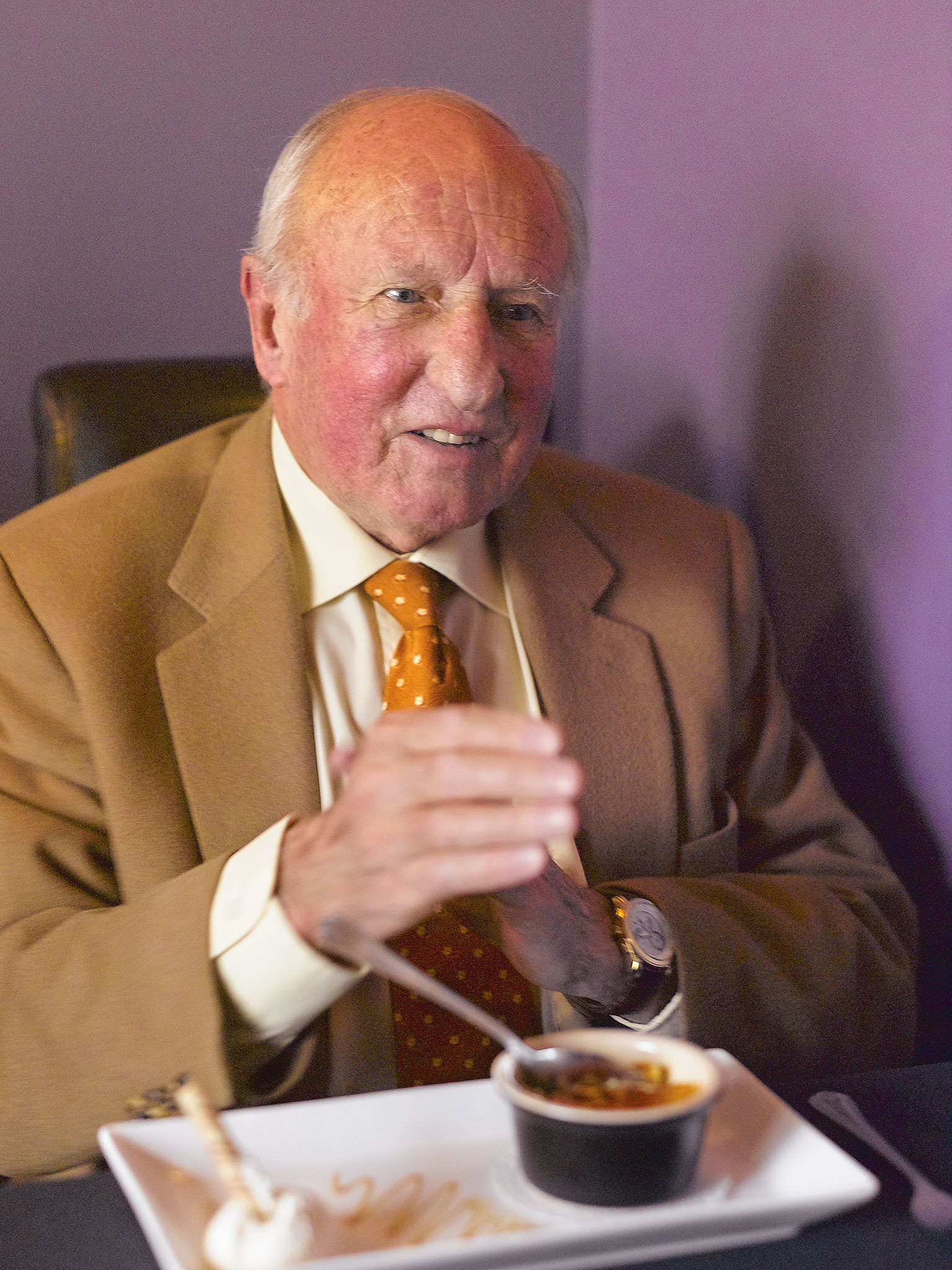Lunch with... Jack Sears
The epitome of the Gentleman Racer, Jack Sears also possessed a steely edge that he put to good use on the race track – but he always saw himself as a team player.
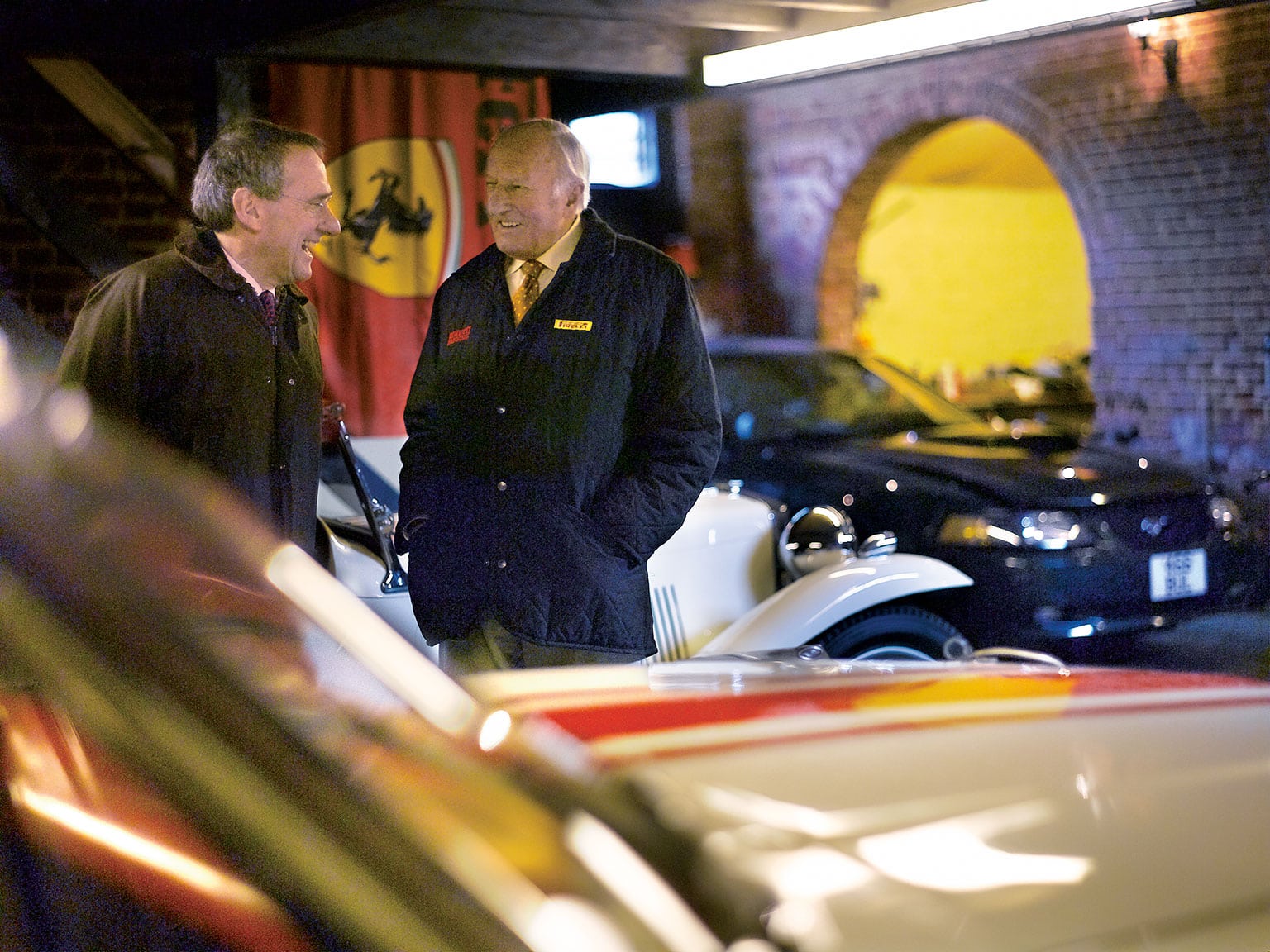
James Mitchell
Nowadays “Professional” tends to mean doing something properly, and “Amateur” can mean the opposite. But, back in the days of Gentlemen and Players, you’d only be a Player, and get paid for taking part in a sport, if you didn’t have the means to be a Gentleman. In the 1950s, few racing drivers were pure professionals: Stirling Moss was a rare exception. Most of the others had businesses of one sort or another behind them, or were independently wealthy. This was because – apart from a very few at the top level – even works drivers were paid little, if anything at all.
Jack Sears was the first man to win the British Saloon Championship, the forerunner of today’s BTCC. But he had to buy the car he raced. He was a works BMC rally driver in big Healeys and Austins, and raced Jaguars, Aston Martins and Ferraris with great success for top teams of the day like Equipe Endeavour, Maranello Concessionaires and John Coombs. But for all this he was never paid a penny. That was how things were in those days. John Willment was the first to make him a small payment, when he was racing his Cobras and Galaxie in 1963. Then came a modest retainer from the Ford Motor Co when he joined Team Lotus in 1965 to race Cortinas with Jim Clark, and became a key member of Carroll Shelby’s Cobra team for its successful onslaught on the GT World Championship.
In fact, all Jack ever wanted to do was be a farmer. His grandfather left school at 14, and made the family’s fortune building up a hugely successful shoe business around the turn of the last century. His father, Stanley Sears, had engineering interests and a farm in Sussex, and was one of the world’s first dedicated car collectors. He began buying veteran and vintage cars in the 1930s, at one time owning as many as 40, and ended up with a priceless array of Rolls-Royces. So Jack’s was a privileged upbringing. While still a schoolboy at Charterhouse he was given a Morgan 4/4, and immediately took part in rallies and sprints.
In 1949 he and his younger brother were given a matching pair of MG TCs. Jack raced his at Goodwood, and soon fitted a Wade supercharger.
His father’s collection included the ex-Dario Resta 1914 TT Sunbeam, and Stanley offered it to Jack for the 1951 VSCC Silverstone. He took to this big, heavy old car at once, and raced it a lot. “No front-wheel brakes, and a crash gearbox, but if you drove it according to its capabilities it handled better than you would believe. The Sunbeam taught me a lot about exploring the potential of difficult cars.”
After the Royal Agricultural College in Cirencester Jack bought Uphall Grange, a 600-acre farm in Norfolk, and moved there with his young wife Cicely. Today, 57 years later, he still lives there. Cicely died in 1995, but since 1997 his constant companion has been his charming second wife, Diana. He’s 80 now, but he runs the farm totally hands-on, with a small staff. For this very English gentleman farmer, the right place for our lunch could only be a traditional Norfolk pub: home-cured ham and eggs at the delightful Windmill Inn at Swaffham.
In one of the farm’s immaculate barns he keeps just four old cars that are special to him, all charged up and on the button. One is the flawless Thrupp & Maberley Phantom III that his grandmother bought off the Rolls-Royce stand at the 1938 London Motor Show. It has still only done 36,000 miles. Another is one of the fastest vintage Bentleys in the world, the ex-Forrest Lycett 8-litre, which his father took over from Lycett’s estate 50 years ago. There’s a 100-point MG TC, cream with red leather, just like the one he had in his teens; and his winning mount in the 1963 British Saloon Championship, the mammoth white and red Willment Ford Galaxie.
When Jack first took over Uphall Grange the farm absorbed every waking moment, but before long he found time to race a Cooper-MG sports-racer, an open XK120 Jaguar and then an XK120 coupé. Among the enthusiasts he met on the East Anglian car scene was Archie Scott Brown.
“Archie was a rep for a tobacco company, living in Cambridge. He was very much a Scot, sounded like a Scot. His legs were much shorter than normal and his feet pointed in odd directions, and his right arm finished just below the elbow. The stump had a sort of vestigial thumb which he could push against the steering wheel, to hold it while he changed gear with his normal left hand. His mother had caught German measles while she was expecting him, and he’d been like it since birth. As a child he endured endless operations to turn his feet, and his legs were in irons for years. But he never thought of himself as disabled, didn’t seem to consider it at all. When I first knew him he was doing sprints with a hotted-up MG TD, and already he was very quick. Brian Lister, who ran an engineering business in Cambridge, had done some racing in a Tojeiro-JAP, and lent it to Archie, who was far faster. So Brian built the first Lister for him, with an MG engine. To start with he was just doing club events, but when they went to the British Empire Trophy at Oulton Park in April 1954 Archie was quickest in the class in practice, ahead of Stirling and everybody. It attracted a lot of attention. There were no medical checks in those days, but suddenly people noticed he had no right hand, and officials asked questions. On race morning they told him they were suspending his licence pending a medical enquiry by the RAC. Archie was absolutely shattered.”
Several fellow drivers, including Moss and Anthony Crook, wrote to the RAC in support of Archie, and two months later, after examination by former Le Mans winner Dr Dudley Benjafield, his licence was restored. In the interim Archie suggested to Brian Lister that Jack drive the Lister-MG, and Jack scored a win at Snetterton and several class placings. “When Archie got his licence back Brian had finished the Lister-Bristol, and he started winning a lot. It was a good car, and I raced one of my own for the 1955 season. The race Archie really felt good about was the 1955 British Empire Trophy, one year on from his suspension, same race, same place. He won it outright, in the wet, ran circles round the opposition, like the works Astons of Parnell and Collins and the big Jaguars. After that nobody talked about his disability.
“Although his feet were small and not fully formed, he was brilliant in a Le Mans start. He moved very quickly, and you didn’t notice his gait. He had amazing balance. I know he always won slow bicycle races at school – everybody else moved off and he’d just stay where he was, balancing.
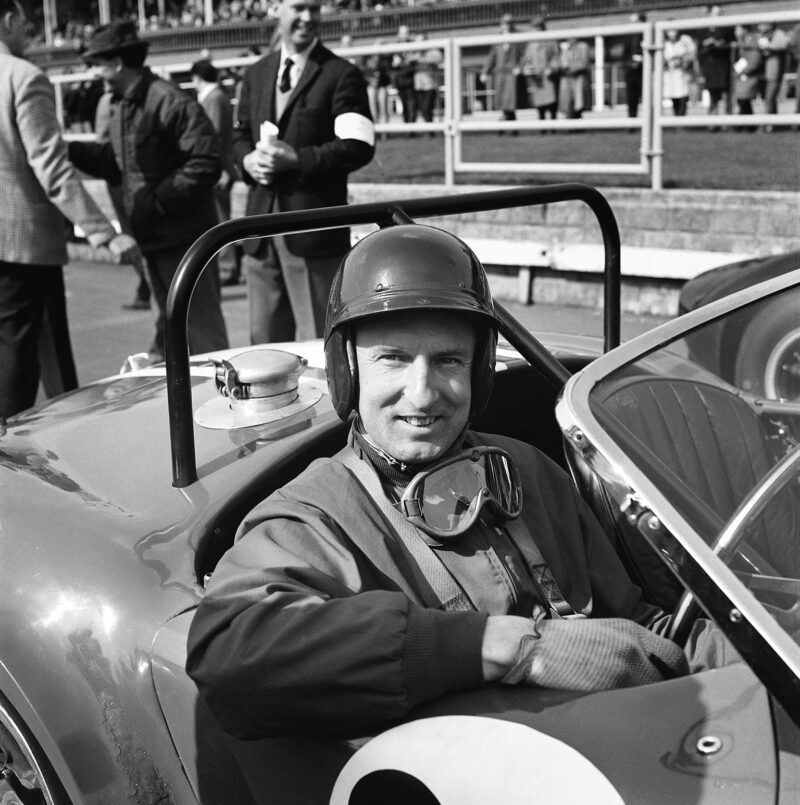
At the wheel of the Willment Cobra in which he scored his famous Brands victory
Motorsport Images
“I was due to do the 1956 Monte Carlo Rally with Peter Reece in an Austin A50. The standard A50 was about the slowest thing on the road, but this had an MG engine and floor change. Then, just before the rally, Peter was killed in a road accident. Archie and I went up to Liverpool for the funeral in Archie’s Ford Zephyr. As a road driver Archie was, um, quick. He had the seat close to the wheel to get his short legs on the pedals, and he smoked a lot. Steering with his stump he’d give the packet a flick, put his next cigarette in his mouth and light it, all at 80mph. After the funeral Peter’s father said, ‘I still want the car to run in the Monte. I want you to go, Jack, and I want you to go with him, Archie, because Peter always admired your driving.’ Archie said, ‘Well, I don’t really do rallies,’ but I said, ‘Come on, Archie, let’s do it for Peter’s sake.’
“We started from Lisbon, with Ken Best as our No 3, and the weather was foul. All the way across Spain it rained and rained. We got to Monte Carlo in 50th place out of 300 starters. I knew Archie was quicker than me, so we agreed he should drive on the final 150-mile mountain circuit. His car control was fantastic. He’d throw the car sideways entering a corner, the way rally drivers adopted years later. His stump steadied the steering wheel while he changed gear, and his reactions were absolutely amazing. Coming down the Turini, approaching a right-hander, Archie suddenly announced: ‘The bloody brakes have gone.’ He threw the car sideways but it slid to the edge and toppled over, landing upside in the forest below. We clambered out, villagers appeared from nowhere, and with their help we pushed the car on its roof like a toboggan through the trees into a clearing, and put it back on its wheels. The glass was all gone, but Ken kicked the roof up from the inside, we checked the oil and water, and it started. So we set off again. But everything was bent and the car was almost undriveable, so we lurched back to Nice, had a good lunch, and then timed our drive to the finish by the harbour at Monte Carlo exactly right, so everybody thought we’d done the whole mountain section in this dreadfully damaged car and come through. Of course when they saw the road book they realised we’d missed half the controls. But they still classified us 76th.
“After that Archie said, ‘Thanks very much, no more rallies for me.’ But I went on to do a lot more internationals for BMC: A90s, then the hotter A105, and also the big Healey 100/6. Later I did Sebring and Le Mans with Peter Riley in UJB 143, the Healey that was sold on to David Dixon and became DD300. I gave up rallies after that, although in 1960 I did do the first RAC to incorporate loose-surface stages. I took Willie Cave in Peter Berry’s Jaguar 3.8. Hardly suitable, but we finished fourth overall behind Carlsson’s Saab, Sprinzel’s Sprite and Don Morley’s Healey.
“In 1958 the British Saloon Championship was launched, and I bought an Austin A105, TOL 563, which I ran with unobtrusive works support. Jeff Uren had a Ford Zephyr with Raymond Mays’ three-carb head, which was quicker, so we got Speedwell to make up a three-carb head for the Austin. That did the trick.” The championship was run on a class basis, and after the final round at Brands both Tommy Sopwith (Jaguar 3.4) and Jack in the Austin were on maximum points. The title was resolved by a duel between two identical Riley 1.5s, two five-lap heats with the drivers swapping cars in between. Gordon Cruickshank told that story in the June 2008 issue of Motor Sport: suffice to say that on aggregate Jack took the title by 1.6sec. “In the pictures afterwards Tommy looks a bit bemused, because he really thought he could beat me. I’ve got my tie tucked into my shirt – I’d always arrive in a jacket and tie, and then take off my jacket and lay it on the back seat to do the race. Almost no-one wore overalls in those days, except Stirling.

Sears’ Lister-Bristol at the 1955 Empire Trophy at Oulton Park. His close friend Archie Scott Brown won the race
Motorsport Images
“After Tommy retired from racing he ran Equipe Endeavour as a serious operation, and I drove for him a lot: Jaguar 3.8, E-type, DB4GT Aston, Ferrari 250GT. He said, ‘I can’t pay you anything, Jack, but when we go to races I’ll pick up the bill for the hotel.’ We always stayed in the best hotels, with the best food and wine, but I had to pay for the fuel to get myself there, and all start and prize monies went to the entrant. At BMC they’d give you a small daily expenses allowance, and you had to survive on that.
“In 1960 Ken Gregory, who was running the Yeoman Credit team, asked me to drive a Formula 2 Cooper at Crystal Palace. An engine fire meant we missed practice, so I started from the back of the grid. It was pouring with rain, but I came through to finish third, and shared fastest lap with the winner, Trevor Taylor in the works Lotus 18. Ken got all excited, and I did another race at Snetterton, but the car broke. Then he offered me a permanent drive for the following season. I had three young children by then, I was running the farm, I had the drives for Tommy Sopwith, so I turned it down. That was the end of my single-seater career.
“There was always tremendous rivalry between Tommy and John Coombs. Michael Parkes and I drove Tommy’s 3.8 saloons, and Roy Salvadori drove Coombs’ 3.8. Our engines were all done by the works, and it was more than Lofty England’s life was worth to give a better engine to Tommy or to John. But we had the advantage of Michael, who was a superb development engineer, working for Rootes at the time on the Hillman Imp. He made some suspension modifications which the scrutineers never knew about, fitted firmer bushes. I don’t know if they were legal or not, but we always thought our cars handled better than the Coombs cars.
“Roy was a very fine driver, but he was inclined to push and shove. He had me off once at Crystal Palace. I was in the Sopwith 3.8, Roy was in the Coombs 3.8, and he came up the inside going too fast to make the corner and slammed into me. I went into the sleepers, he won the race. The British Grand Prix meeting at Aintree in 1962 was fun because Coombs got a fellow called Bob Jane to drive his car. He was unknown to any of us, but he was billed as the Australian saloon champion. He was very cocky and full of himself. Mike and I were relatively friendly towards him, as we should be, and in practice he split us on the front row of the grid. He was strutting about a bit after that, so Michael and I decided we’d have to box a bit clever, because we mustn’t let him win. Well, he led from the start from Michael and me, and we stayed like that for several laps, Michael very close, harassing him. Coming down to Melling Crossing, which was a very fast left/right, Jane got on the grass and lost it. In avoiding him Michael also got on the grass, and I took the lead, with Michael behind me and Jane third. Near the end Jane retired, his head gasket went, but he and Michael had words afterwards. Michael always maintained that he never touched Jane, that Jane went off by himself.

May, Silverstone, 1963 and the start of a winning streak for the Willment Ford Galaxie
Motorsport Images
“Mike Parkes was a lovely man, gentle and charming. His father was chairman of Alvis, and after Rootes he went to Ferrari. He did six Grands Prix for them, pole and second place at Monza, second at Reims, and won two non-championship F1 races. Then he had a bad accident at Spa and smashed his legs. He carried on working for Ferrari after that, and I remember staying with him at Modena and riding down the autostrada in a 275GTB four-cam, 165mph among the Fiats. He introduced me to several of his Ferrari friends, like Lodovico Scarfiotti and Lorenzo Bandini. I was devastated when he was killed in a road accident in 1977. The ironic thing was that when my son David was born I asked Archie Scott Brown to be his godfather. When Archie was killed in 1958 I asked Michael to take over the responsibility, which he did.
“I drove for Tommy Sopwith for three years, 1960 to 1962, and I also did the 1962 Tour de France in a 3.8 for a French privateer, Claude Lego. He did the hillclimbs and I did the circuits. I won at Rouen and Le Mans, and then at Clermont I was in the lead, totally flat into a very fast downhill bend, and I came up to lap Marang’s Citroën DS. He got the blue flag and I was flashing my lights, but still he didn’t see me and moved across on me. It was a very big accident. No rollcages then, of course, and I hadn’t put my belts on, because it was a Le Mans start. I was going to put them on when I got to the straight, but it had all been a bit frantic in the early laps. The Jaguar’s roof was totally flattened down to the doors, and I came out through the back window. I got to my feet, Marang was standing by the wreck of his car, and I called him all the French words I knew and a few English ones too. No ambulance appeared, so I started to walk back, but by the time I got to the pits I could hardly stand. Claude and Denise Lego drove me to hospital, and they found three fractured vertebrae. I was in a plaster cast for months. Sir Gawaine Baillie’s 3.8 went off on the same lap, and we ended up in adjoining beds in the same French hospital.”
For 1963 Jack joined John Willment. He repeatedly won his class in the team’s Cortina GT, and then the Galaxie arrived at Silverstone in May. To the surprise of Salvadori, Graham Hill and the rest of the Jaguar contingent, Jack put it on pole. After a careful start because the car had high NASCAR gearing, he ran away with the race, doing the whole distance in top gear to save the clutch. For the rest of the season – even around the tight confines of Crystal Palace – Jack dominated the category, earning his second British Saloon Champion title.
“Ronnie Hoare – known to everybody as ‘The Colonel’ – ran Maranello Concessionaires, the British Ferrari importer. He oozed charm, loved the ladies. Michael Salmon does a wonderful impersonation of his drawling voice – you’d think he was The Colonel reincarnated. For Le Mans in 1963 The Colonel ordered a new 330LMB, and asked Salmon and me to drive it. Ronnie flew down to Italy, collected the car from the factory, drove it to Le Mans, and his mechanics gave it its pre-delivery inspection in the paddock. If you could get to the end there you usually did well, so Mike and I decided to drive sensibly, eight-tenths all the way. We finished fifth overall, and won the class.
“A couple of months later, at the Guards Trophy meeting at Brands Hatch, I was driving the Coombs GTO and Lorenzo Bandini was in the LMB. In practice The Colonel asked me to try the LMB because Bandini didn’t seem to be very happy in it. Of course I was familiar with the car after Le Mans, and familiar with the circuit, so I chucked it about a bit. The Colonel said, ‘Very interesting, you’re quicker than Bandini.’ I was secretly thrilled to be faster than a Ferrari F1 driver in the same car. The GTO was far nicer round Brands than the LMB, which simply didn’t handle as well. The bigger engine didn’t rev as high, and it had a four-speed gearbox instead of a five-speed. That day I won the GT category after a duel with Innes Ireland’s Project 214 Aston – Roger Penske won overall in the Zerex Special – and Bandini was fourth GT home behind David Piper’s GTO. The GTO really was as good as its reputation, for me the best front-engined Ferrari of all time. In 1970 I was able to buy that same Coombs GTO, and it was in the family for 29 years.”
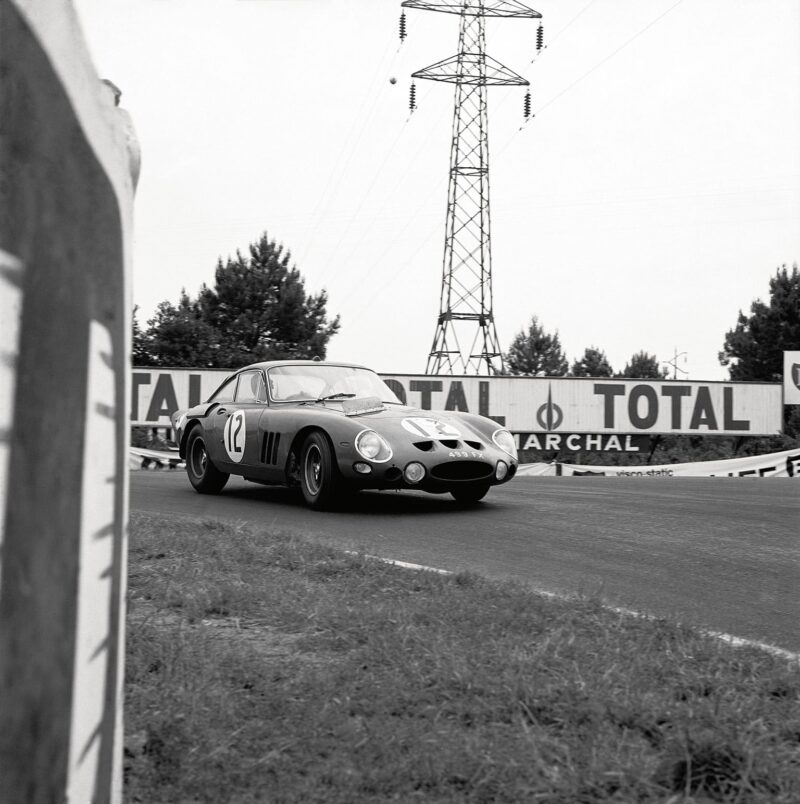
Sears and Mike Salmon were fifth overall and class winners at Le Mans in 1963 in new Ferrari 330LMB
Motorsport Images
Jack is the only man to have campaigned the 4.7-litre AC Cobra in all its racing forms – the roadster, the Shelby Daytona coupé, the one-off Willment coupé and the works A98 Le Mans car. The latter featured in the notorious 185mph M1 incident. “I was to drive it at Le Mans with Peter Bolton. We’d run it round MIRA, but we could only make 165mph on the straight there, and the banking was quite tight. The M1 was the obvious choice – there was no speed limit then, so it was perfectly legal. There was much less traffic in those days, and at 4am the place was deserted. We had two sets of tyres to try, Goodyears and Dunlops, and we swapped them over at the motorway services. If I did see a car ahead I lifted off so I didn’t frighten the driver. I got to the point where it just wouldn’t go any faster, noted the revs and peeled off, went back down the other side to the services, and the engineers checked their slide rules and said I had been doing 185mph. Peter Bolton did some runs too, and by 5.30am we’d finished and went home.
“Unfortunately the nephew of AC boss Derek Hurlock, who’d come along to watch, talked about it in a Fleet Street wine bar. A journalist picked it up, and suddenly the story was everywhere. It caused an awful furore, questions were asked in the House, there was lots of tut-tutting. And subsequently, when the 70mph limit came in, people assumed, completely wrongly, that it was all because of our AC test. It wasn’t, of course – Barbara Castle, the Minister of Transport, later confirmed that they’d already been evaluating a blanket speed limit for some time. Of course we weren’t the only ones: in those days Jaguar used to come out of Browns Lane and use the M1, so did Aston Martin from Newport Pagnell and Rootes from Ryton-on-Dunsmore with the Tigers. Everybody used the M1. But of course nobody had done 185, and nobody had talked about it in a Fleet Street bar. The race didn’t end well, either. While Peter was driving the car on Saturday evening a rear tyre blew on the fast stretch up to White House. He spun and was collected by Giancarlo Baghetti’s Ferrari, and they both ended up in the ditch.”
Another much-publicised incident came at that year’s British GP meeting at Brands. In the GT race poleman Bob Olthoff non-started. As the grid formed up Jackie Stewart, in John Coombs’ E-type, moved from the centre of the front row to pole, and third qualifier Roy Salvadori, in Tommy Atkins’ Cobra, moved to the middle. In practice Jack hadn’t been happy with the Willment Cobra, which had been hastily rebuilt after Frank Gardner cartwheeled it in the Nürburgring 1000Kms when the engine seized. He’d qualified it fourth, putting him on the inside of row two. But, arriving on the grid and seeing the others had moved up, he parked on the outside of the front row.
“In fact the inside of the second row would probably have been a better starting position, because I could have followed Jackie through to Paddock Bend. As it was I got away fourth. Coming past the pits at the end of the second lap there’s the black flag with 32, my number. I think, there must be something wrong with my car, so I come in, stop opposite my pit, and an official leans into the car and bellows at me, ‘You started from the wrong place on the grid. This is your penalty. Now you can go.’ I was furious. I shot off down the pitlane, shaking my fist, and if you could have heard my voice above the Cobra’s exhaust I was effing and blinding at everybody. It was only a 20-lap race, and I was last, so I had to wend my way through everybody, headlights on full beam.
“Compared to the GTO, the Cobra was a much more crude thing to drive. Everything flexed with the torque of that big V8, that was part of its inconsistent handling. But I did things that day I’d never done before, and never did again – because I was so angry. I gave it the full treatment, I braked later, I pushed harder, and suddenly I was two seconds a lap quicker than I’d been in practice. I sliced past everybody. Caught David Piper, who was third, had him for breakfast. Salvadori was second, had him for lunch. Stewart was a different kettle of fish. The Cobra had more grunt, but the E-type handled better. But I wound him in, and with four laps to go I got inside him at Westfield when he didn’t expect it, and went ahead. I won the race, and set a new lap record. It was as if somebody else were driving the car.
“Afterwards I was called before the stewards. The chairman, the Marquess Camden, heard what I had to say about the muddle on the grid, and then said, ‘We’re not going to take any further action on this occasion, but in future please start from your correct grid position.’ I said, ‘Thank you very much, sir. Sorry to have been a nuisance.’ And then he said, ‘Damned good race, wasn’t it…’”
What Jack didn’t know was that John Willment was so enraged by the black-flag business that he manhandled Deputy Clerk of the Course Basil Tye in the pitlane, and Mr Tye tumbled into an ornamental flower bed under the race control building. Willment was found guilty of an act prejudicial to the interests of motor sport, fined £100, and declared persona non grata at all RAC-organised meetings for the rest of the season.
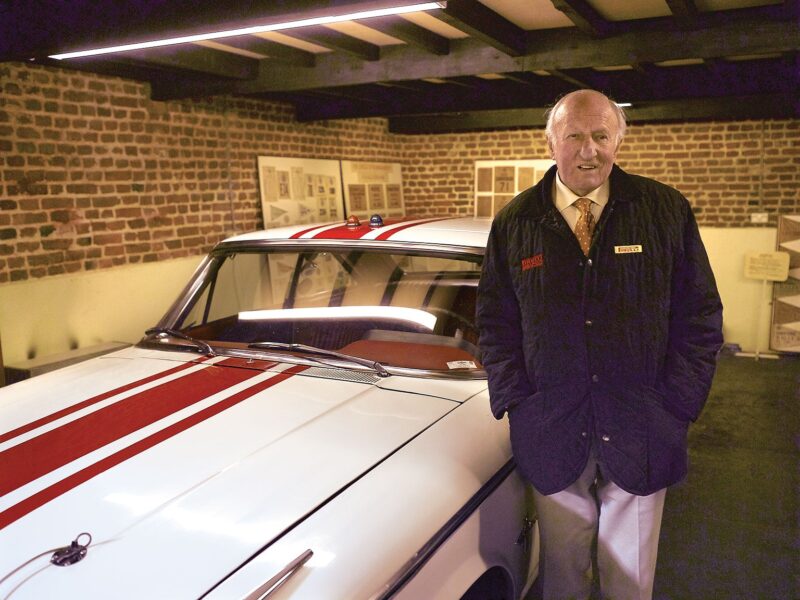
Sears small but prized car collection includes 1963 BSCC-winning Galaxie
For 1965 Walter Hayes of Ford offered Jack a retainer which covered driving the works Lotus-Cortinas alongside Jim Clark, and also joining the Shelby Cobra team in its battle with Ferrari for the GT World Championship.
It was to be Jack’s finest season, but it was also to be his last.
“Being team-mate to Jimmy was a huge privilege, because he was the best driver in the world. We’d go testing together and I’d try to work out why I was slower than him. I learned a lot, and got quicker as a result. His sense of balance was uncanny. I’d follow him and think, I’ve got this taped now, but he’d just inch away from me. At the next corner he’d be six feet further away, at the next 15 feet further away. I’d sit there, thinking about it: we were both doing the same, both lifting the inside wheel just as high, and the two cars were identical. He followed me on one or two occasions, and he said, ‘Try braking a little bit earlier, then you can get the power on earlier.’ And he was right. But he could do it better than me, his exit speed out of the corner was always a tiny bit higher.
“We got on very well because we were both farmers, we spoke the same language. He was easy to be with. But he didn’t know how to deal with the fame that was rightfully his, he was uncomfortable with it. He was a nail-biter, all his nails were chewed right down. He and Colin Chapman bonded hugely, of course. That was an amazing friendship: Colin worshipped Jimmy, and Jimmy worshipped Colin.
“At the 1965 British Grand Prix meeting, because Jimmy was in the F1 race, John Whitmore took over his Lotus Cortina. I always thought I was a bit quicker than John, and he thought he was a bit quicker than me, so here was the showdown. After three or four laps of serious duelling, ten-tenths stuff because we were both determined to win the class, we went past the pits and Colin Chapman was making ‘Cool it’ signs to us. He didn’t want us having each other off. So on the Hangar Straight I lifted fractionally to let John come alongside and, holding the steering wheel with my knees, I held up my two hands side by side. He got the message at once. We started lapping two seconds a lap slower, still passing and repassing so we were putting on a good show for the public. On the last lap we came through Woodcote – which was a fast corner in those days – and we did the dead-heat perfectly. The only thing was that John ran wide, so when we crossed the line he had all four wheels on the grass. But the timekeepers agreed – we’d both won the class.
“For the past three years Ferrari had won the GT World Championship, but Shelby and Ford were determined to conquer them. The Daytona Cobra coupés were much stiffer than the roadsters, because the bodywork incorporated extra structural tubes, and I thought they handled pretty well. An awful lot noisier inside, though. I only saw Carroll Shelby when we got to Le Mans, because Alan Mann co-ordinated the European effort. He was fantastic. He was only 28 then, but very businesslike and well-organised, and amazingly decisive. We raced to strict orders – which Bob Bondurant sometimes had trouble with, but which John Whitmore and I followed absolutely. And, as a team, we did beat Ferrari and win the World Championship.
“It was a long, hard season: Monza, Oulton Park TT, Nürburgring 1000Kms, Reims, Enna. At Le Mans every one of the Ford cars retired – all the GT40s, and all the Cobras – except our Daytona coupé. I was paired with the American dentist Dr Dick Thompson, a nice guy, and by the end the oil pressure was falling to zero on corners. We nursed it to the finish, driving on the pressure gauge, and still finished second in class. I always liked Le Mans: only two drivers per car then, of course. You’d do three hours on and three hours off, with a refuelling stop halfway through each stint. When I got out of the car I’d sleep for about an hour, then Cicely would wake me, give me some food, I’d shower and change, and be ready for the next stint. My days in rallying, when sometimes you ran for three days and nights without getting into bed, taught me how to snatch sleep anywhere.
“Colin Chapman decided I was quite a useful test driver and asked me to do some sessions with the Lotus 30, which I accepted with enthusiasm because it was a pretty punchy car. I only raced it once, at Silverstone, finished third behind Bruce McLaren and Hugh Dibley. Then came the Lotus 40, which had a 5.3-litre engine and was certainly quicker, but I didn’t like it. It was very twitchy. Ritchie Ginther memorably said it was the Lotus 30 with 10 more mistakes, and I don’t think Jimmy could make much of it, either. At the end of September I did a Lotus test at Silverstone. First I drove Jimmy’s Indy-winning Lotus 38 four-cam, which had been fitted with symmetrical suspension so Jimmy could demonstrate it at a Swiss hillclimb. Jim Endruweit, the chief Lotus mechanic, told me just to make sure it started and stopped and handled. I’d never been in such a fast car in my life. The power, the acceleration, were fantastic.
“Then we started tyre-testing with the Lotus 40. After several stints I came up to Abbey Curve on the old GP circuit, probably doing about 150mph, and I started to drift towards the grass. I woke up in the ambulance going to Northampton Hospital. My left arm was almost severed when I was trapped under the overturned car, and the header tank split and covered me with scalding burns which became infected.” It took many months for Jack to recover, and he realised that, aged 35, his racing career was over.
However, his life continued to be very full. As well as the farm, he took up flying with his friend Whitmore, and in 1967 Sopwith inveigled him into the organisation of the London-Sydney Marathon. For a while this became a full-time job, with an office and secretary in London and a full recce to Sydney with Tony Ambrose. Later he had a stint as BRDC president, and became long-time chairman of the Ferrari Owners’ Club.
Meanwhile his son David set about his own racing career – without encouragement from his father, who didn’t want to feel responsible if he hurt himself. After double Formula Ford titles and a Grovewood Award in 1979, David went through F3, touring cars and long-distance sports car racing, finishing second in the 1984 TT in a Walkinshaw Jaguar XJS and third at Le Mans in 1990 in a Porsche 962. He went on to build a substantial empire as a driver manager and team boss, and his Norfolk-based Super Nova Racing team won more F3000 races and titles than any other. Now it’s a major player in GP2 and GP2 Asia.
As for Jack, he still epitomises the Gentleman Racer soubriquet with his courteous good manners, his immaculate grooming, his precise but always modest memories of his racing exploits. But you can still discern, just under the surface, the hard competitive edge that would emerge when he was at the wheel of a big, hairy car – the raging spirit that, on a July afternoon at Brands Hatch in 1964, even Jackie Stewart could not defeat.
